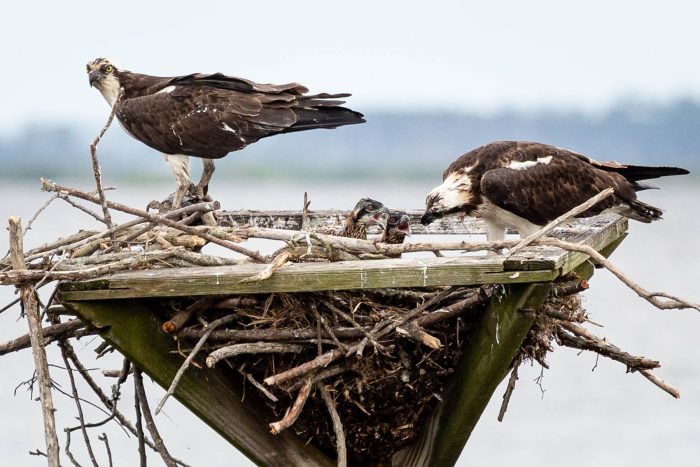xOsprey
Pandion haliaetus
Also known as the fish hawk, the osprey is a large raptor with distinctive brown and white patterning. It visits the Chesapeake Bay's tidal waters, including its shorelines, rivers and marshes, from spring through late summer.
This section shows one large critter image at a time. Use the thumbnails that follow to select a specific image to display here.

This gallery contains a grid of small thumbnails. Selecting a thumbnail will change the main image in the preceding section.
Appearance
The osprey can grow up to 2 feet in length with a wingspan that reaches up to 6 feet. Its hawklike body is patterned with brown and white, including a brownish-black back, black patches in the crooks of its wings and a white head and belly. A broad black stripe runs across its yellow eyes toward the back of its head. Females have a "necklace" of brown-tipped breast feathers.
Feeding
The osprey feeds almost exclusively on medium-sized fish, including perch, shad and menhaden. It hunts for food while flying high above the water. Once an osprey spots its prey, it will hover in the air while beating its wings before diving toward the water and plunging in, feet-first, to capture its meal. Back in the air, the osprey will rearrange the fish in its feet so the fish is facing forward. This reduces drag, making it easier for the osprey to fly.
Flight
Osprey can be identified in flight by their crooked wings, white underparts and black eyestripes.
Voice
Up to five different calls have been recognized by researchers, used for begging, alarm, courtship and nest defense. The most frequent call is a piercing, chirping cheep-cheep or yewk-yewk. When they are near their nest, ospreys may make a sharp, frenzied cheereek.
Reproduction and life cycle
Historically, the Chesapeake Bay has supported the largest concentration of breeding ospreys in the world. Ospreys are typically monogamous, reaching sexual maturity at age three and often mating with the same partner for life. Breeding pairs have been known to return to the same nest site year after year.
Experienced breeders begin to arrive at old nest sites in late February or early March, while less experienced breeders arrive later in the season and can spend several weeks finding a mate and nesting site. Males arrive before females. Courtship and nest building or repair begin once a pair has reunited. Large, bulky nests are built using branches, corn stalks, shoreline debris and other materials. Nests are often located near the water on tall structures like dead snags, utility poles, channel markers and nesting platforms. Access to trees or man-made platforms to nest in is crucial for the survival of ospreys, as they need a place to safely keep their eggs from predators. Each summer, you can watch osprey eggs hatch through nesting cams from the Chesapeake Conservancy or Chesapeake Bay Foundation.
Estimates from the Center for Conservation Biology place the current osprey population in the Chesapeake Bay at eight to 10,000 breeding pairs, with the world population estimated at fewer than 100,000 birds.
Did you know?
- Ospreys are one of the largest raptors in North America and one of the most widespread birds in the world. They are found on every continent except for Antarctica.
- Approximately one-quarter of all ospreys in the contiguous United States nest in the Chesapeake Bay region.
- Osprey populations have slowly recovered since the middle of the twentieth century, when widespread use of the pesticide DDT caused the species to decline.
Sources and additional information
- Life in the Chesapeake Bay by Alice Jane Lippson and Robert L. Lippson
- Chesapeake Bay: Nature of the Estuary, A Field Guide by Christopher P. White
- Animal Diversity Web: Pandion haliaetus – University of Michigan Museum of Zoology
- All About Birds: Osprey – The Cornell Lab of Ornithology
